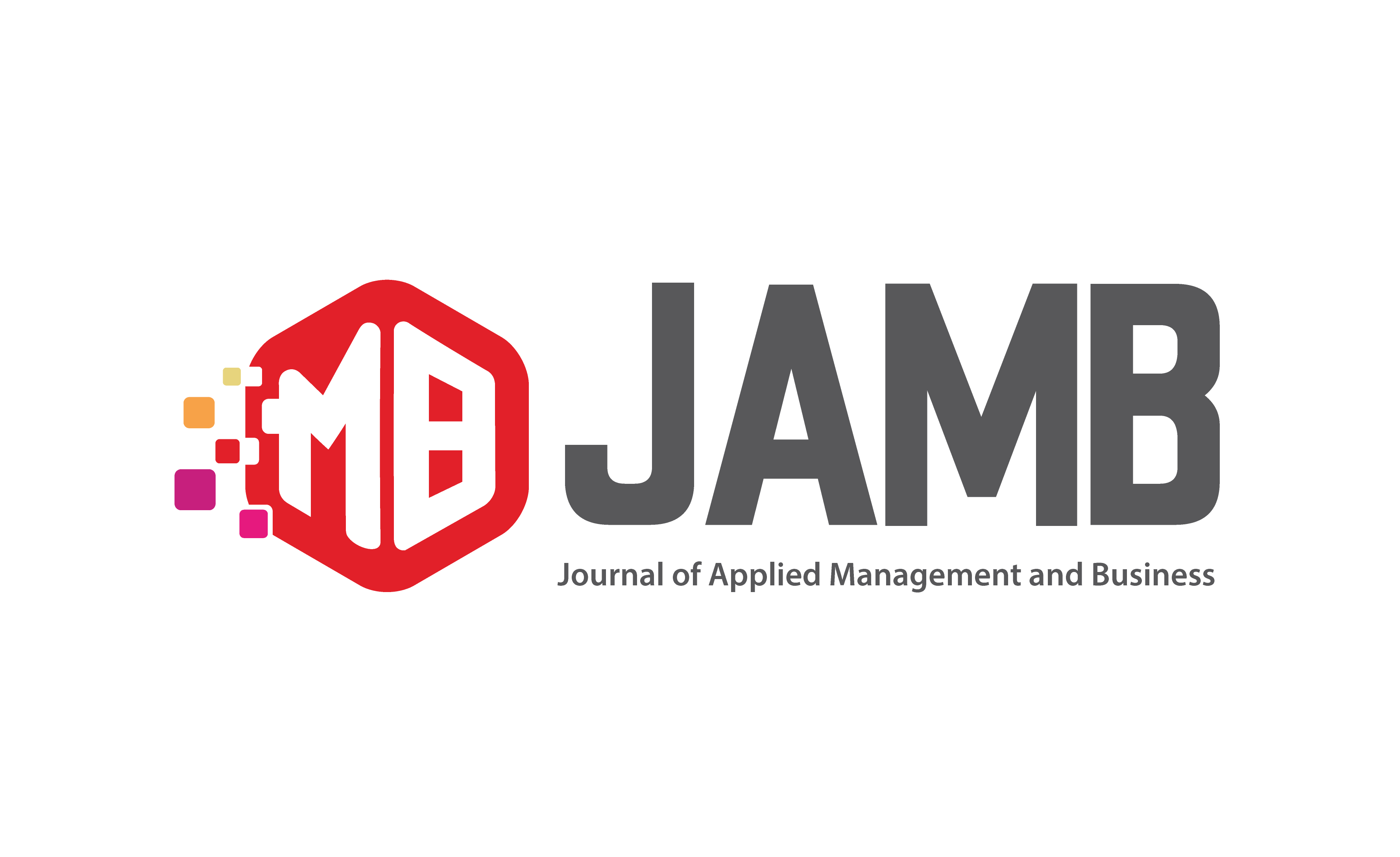The Impact of Job Satisfaction and Role Conflict on Turnover Intention of Bakti Timah Nurses
DOI:
https://doi.org/10.37802/jamb.v4i2.421Keywords:
Role Conflict, Turnover Intention, Work EngagementAbstract
Turnover intention causes increased costs for health organizations and reduces nurse performance. The research is aimed at knowing the impact of job satisfaction and role conflict on turnover intention. Respondents were 91 nurses at the Bakti Timah Pangkal Pinang hospital who were taken by purposive sampling method. The research design is quantitative causality with the data analysis method, namely PLS SEM. The results of the study found that job satisfaction has a negative impact on turnover intention, while role conflict has a positive impact on turnover intention. Future researchers can use the mediation of work engagement, work stress, and commitment to explain the weak relationship between variables.
Downloads
References
M. A. Roche, C. M. Duffield, C. Homer, J. Buchan, and S. Dimitrelis, “The rate and cost of nurse turnover in Australia,” Collegian, vol. 22, no. 4, pp. 353–358, 2015.
C. M. Duffield, M. A. Roche, C. Homer, J. Buchan, and S. Dimitrelis, “A comparative review of nurse turnover rates and costs across countries,” J. Adv. Nurs., vol. 70, no. 12, pp. 2703–2712, 2014.
Y. Wong, Y.-W. Wong, and C. Wong, “An integrative model of turnover intention: Antecedents and their effects on employee performance in Chinese joint ventures,” J. Chinese Hum. Resour. Manag., vol. 6, no. 1, pp. 71–90, 2015.
J. Lee, “Nursing home nurses’ turnover intention: a systematic review,” Nurs. open, vol. 9, no. 1, pp. 22–29, 2022.
L. J. Labrague et al., “Predictors of nurses’ turnover intention at one and five years’ time,” Int. Nurs. Rev., vol. 67, no. 2, pp. 191–198, 2020.
M. Takase, S. Teraoka, and Y. Kousuke, “Investigating the adequacy of the Competence‐Turnover Intention Model: how does nursing competence affect nurses’ turnover intention?,” J. Clin. Nurs., vol. 24, no. 5–6, pp. 805–816, 2015.
B. Yildiz, H. Yildiz, and O. Ayaz Arda, “Relationship between work–family conflict and turnover intention in nurses: A meta‐analytic review,” J. Adv. Nurs., vol. 77, no. 8, pp. 3317–3330, 2021.
H. Kim and E. G. Kim, “A meta‐analysis on predictors of turnover intention of hospital nurses in South Korea (2000–2020),” Nurs. Open, vol. 8, no. 5, pp. 2406–2418, 2021.
S. Dutta and P. Khatri, “Servant leadership and positive organizational behaviour: The road ahead to reduce employees’ turnover intentions,” Horiz., vol. 25, no. 1, pp. 60–82, 2017.
Y. Lu et al., “The relationship between job satisfaction, work stress, work–family conflict, and turnover intention among physicians in Guangdong, China: a cross-sectional study,” BMJ Open, vol. 7, no. 5, p. e014894, 2017.
T. S. Kian, W. F. W. Yusoff, and S. Rajah, “Job satisfaction and motivation: What are the difference among these two,” Eur. J. Bus. Soc. Sci., vol. 3, no. 2, pp. 94–102, 2014.
Y. Liu, Y. Aungsuroch, and J. Yunibhand, “Job satisfaction in nursing: A concept analysis study,” Int. Nurs. Rev., vol. 63, no. 1, pp. 84–91, 2016, doi: 10.1111/inr.12215.
M. A. Al Maqbali, “Factors that influence nurses’ job satisfaction: a literature review,” Nurs. Manage., vol. 22, no. 2, 2015.
M. Mubyl and G. Dwinanda, “Analisis Kepuasan Kerja Perawat Terhadap Kinerja, Pelayanan Prima Perawat, Dan Kepuasan Pasien (Studi Pada Perawat Dan Mantan Pasien RSJ Negeri Makassar),” J. Mirai Manag., vol. 5, no. 3, pp. 185–199, 2020.
D. Belias, A. Koustelios, L. Sdrolias, and G. Aspridis, “Job satisfaction, role conflict and autonomy of employees in the Greek banking organization,” Procedia-Social Behav. Sci., vol. 175, pp. 324–333, 2015.
S. J. Creary and J. R. Gordon, “Role conflict, role overload, and role strain,” Encycl. Fam. Stud., pp. 1–6, 2016.
T. C. Dodanwala, P. Shrestha, and D. S. Santoso, “Role conflict related job stress among construction professionals: The moderating role of age and organization tenure,” Constr. Econ. Build., vol. 21, no. 4, pp. 21–37, 2021.
M. L. Griffin, N. L. Hogan, E. G. Lambert, K. A. Tucker-Gail, and D. N. Baker, “Job involvement, job stress, job satisfaction, and organizational commitment and the burnout of correctional staff,” Crim. Justice Behav., vol. 37, no. 2, pp. 239–255, 2010, doi: 10.1177/0093854809351682.
A. Shukla and R. Srivastava, “Development of short questionnaire to measure an extended set of role expectation conflict, coworker support and work-life balance: The new job stress scale,” Cogent Bus. Manag., vol. 3, no. 1, 2016, doi: 10.1080/23311975.2015.1134034.
C. F. C. Bothma and G. Roodt, “The validation of the turnover intention scale,” SA J. Hum. Resour. Manag., vol. 11, no. 1, pp. 1–12, 2013.
F. Alsaraireh, M. T. Quinn Griffin, S. R. Ziehm, and J. J. Fitzpatrick, “Job satisfaction and turnover intention among J ordanian nurses in psychiatric units,” Int. J. Ment. Health Nurs., vol. 23, no. 5, pp. 460–467, 2014.
H. Kuo, K. Lin, and I. Li, “The mediating effects of job satisfaction on turnover intention for long‐term care nurses in T aiwan,” J. Nurs. Manag., vol. 22, no. 2, pp. 225–233, 2014.
A. Alam and M. Asim, “Relationship between job satisfaction and turnover intention,” Int. J. Hum. Resour. Stud., vol. 9, no. 2, p. 163, 2019.
D. Gebregziabher, E. Berhanie, H. Berihu, A. Belstie, and G. Teklay, “The relationship between job satisfaction and turnover intention among nurses in Axum comprehensive and specialized hospital Tigray, Ethiopia,” Bmc Nurs., vol. 19, pp. 1–8, 2020.
S. Zhao et al., “Impact of workplace violence against nurses’ thriving at work, job satisfaction and turnover intention: A cross‐sectional study,” J. Clin. Nurs., vol. 27, no. 13–14, pp. 2620–2632, 2018.
M. Soelton, P. A. Lestari, H. Arief, and R. L. Putra, “The effect of role conflict and burnout toward turnover intention at software industries, work stress as moderating variables,” in 4th International Conference on Management, Economics and Business (ICMEB 2019), 2020, pp. 185–190.
M. Javed, M. A. Khan, M. Yasir, S. Aamir, and K. Ahmed, “Effect of role conflict, work life balance and job stress on turnover intention: Evidence from Pakistan,” J. Basic Appl. Sci. Res., vol. 4, no. 3, pp. 125–133, 2014.
M. H. M. Hoseini, H. Asayesh, S. Amaniyan, F. Sharififard, A. Elahi, and S. Y. Kopaie, “Role conflict and role ambiguity as predictors of turnover intention among nurses,” J. Nurs. Midwifery Sci., vol. 8, no. 1, p. 49, 2021.
S. Han, J. Han, Y. An, and S. Lim, “Effects of role stress on nurses’ turnover intentions: The mediating effects of organizational commitment and burnout,” Japan J. Nurs. Sci., vol. 12, no. 4, pp. 287–296, 2015.
U. Fasbender, B. I. J. M. Van der Heijden, and S. Grimshaw, “Job satisfaction, job stress and nurses’ turnover intentions: The moderating roles of on‐the‐job and off‐the‐job embeddedness,” J. Adv. Nurs., vol. 75, no. 2, pp. 327–337, 2019.
L. J. Labrague, D. M. McEnroe–Petitte, K. Tsaras, J. P. Cruz, P. C. Colet, and D. S. Gloe, “Organizational commitment and turnover intention among rural nurses in the Philippines: Implications for nursing management,” Int. J. Nurs. Sci., vol. 5, no. 4, pp. 403–408, 2018.
Q. Wan, Z. Li, W. Zhou, and S. Shang, “Effects of work environment and job characteristics on the turnover intention of experienced nurses: The mediating role of work engagement,” J. Adv. Nurs., vol. 74, no. 6, pp. 1332–1341, 2018, doi: 10.1111/jan.13528.











